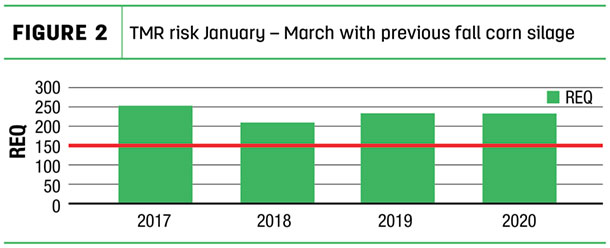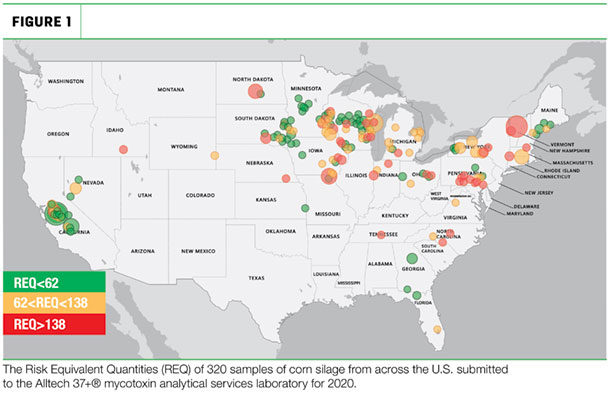2020 was a year we will never forget, no matter how hard we try. The calendar has turned to a new year and we are moving forward, but it is still important for dairy producers to look back and analyze their corn silage for potential mycotoxins and risks as they feed it during the winter months.
Mycotoxins are a concern for livestock producers, as they influence feed quality and animal safety. They are produced by certain species of molds and can have toxic properties that impact animal health and performance.
2020 harvest analysis
In the fall of 2020, 320 samples of corn silage from across the U.S. were submitted to the Alltech 37+ mycotoxin analytical services laboratory in Nicholasville, Kentucky. Analysis of these samples has indicated the Risk Equivalent Quantities (REQ) for dairy cows as 24.5% higher, 25.6% moderate and 50% lower risk levels of mycotoxins (Figure 1).
The samples have included an average of 5.5 mycotoxins, and 98.8% of the samples contained multiple mycotoxins with a range of one to 12 mycotoxins per sample. As the data indicates, mycotoxins are seldom found in isolation, and when multiple mycotoxins are consumed, they may have additive – or even synergistic – interactions that increase the overall risk to the animal’s performance and health. As a result, an animal may have a stronger response than what would be expected if it was only experiencing a single mycotoxin challenge.
In 93.13% of the samples, fusaric acid was present; 81.25% contained type B trichothecenes (DON group); and 71.56% tested positive for emerging mycotoxins, including beauvericin, moniliformin, enniatins, phomopsin and alternariol. These emerging mycotoxins will add to the risks potentially affecting rumen function, gut health and immune response. Fumonisins were also present in 65.94% of the samples.
When comparing the U.S. corn silage crop data from previous analysis in 2017, 2018 and 2019, the 2020 corn silage crop is considered low-risk and is similar to the 2016 crop data (Figure 2).

When looking back at TMR risk for January to March when mixing the 2016 corn silage crop in the TMR, the Risk Equivalent Quantities (REQ) increased to high-risk, so be cautious moving forward, as the mycotoxin risk may increase over time while in storage. Concerns in storage facilities can include variation of stage of maturity and dry matter that can affect packing density and oxygen penetration. Weather forecasts are predicting a warmer winter for 2021, so stabilization that normally occurs in bunkers may not happen and result in increased mycotoxin levels and risks. It’s important to pay attention, test your silage and watch the cows.
Effects of mycotoxins on ruminants
When cows consume feed contaminated with mycotoxins, there can be negative effects that result in long-term declines in performance and, ultimately, lower farm profitability. Chronic mycotoxin consumption, in which smaller quantities of contaminated feed are consumed over time, is often more challenging than an acute single dose, as the mycotoxin risk may not be noticed until a loss of production and health has already occurred.
Although the rumen micro-organisms can help to degrade some mycotoxins, they may also convert other mycotoxins into more potent forms. Certain mycotoxins can pass through the rumen unchanged to be later absorbed in the small intestine, while other mycotoxins may have antibiotic-like effects directly on the beneficial rumen micro-organisms. As a result, the rumen and gastrointestinal tract are main targets of mycotoxins in cows.
Based on the Fusarium mycotoxins (DON and fusaric acid) detected in this year’s samples, cows may show a multitude of symptoms, such as changes to feeding behaviors, rumen disorders, lesions or hemorrhaging of the gastrointestinal tract, altered conception rates, lower milk production or altered milk components, and increased disease occurrence. Dairy animals may also have poor udder health with increased somatic cell counts (SCCs) or increased incidence of mastitis.
Mycotoxin management on-farm
For the feedstuffs that were harvested in 2020 and are currently being fed, it is important to conduct a mycotoxin analysis that identifies the storage mycotoxins, including Penicillium and Aspergillus mycotoxin groups, as there is added potential for additional mycotoxins to develop during storage.
Storage measures may be taken to help reduce the risk of further development of mold and mycotoxins, such as:
- Properly dry grains to less than 13% moisture.
- Improve packing density.
- Ensure that proper fermentation has occurred.
- Inspect storage quality to minimize moisture, air, insect or pest entry.
- Conduct mycotoxin analysis at harvest and after storage to identify the appropriate management strategy for those feedstuffs on-farm.
Mycotoxins are a challenge to animal and feed production, and employing preventive measures for managing mycotoxins is essential to minimize profit loss. Proper mycotoxin management techniques can reduce the risk of mycotoxins coming from feed materials as well as help to prevent the negative effects mycotoxins can have on dairy cow performance and health.







